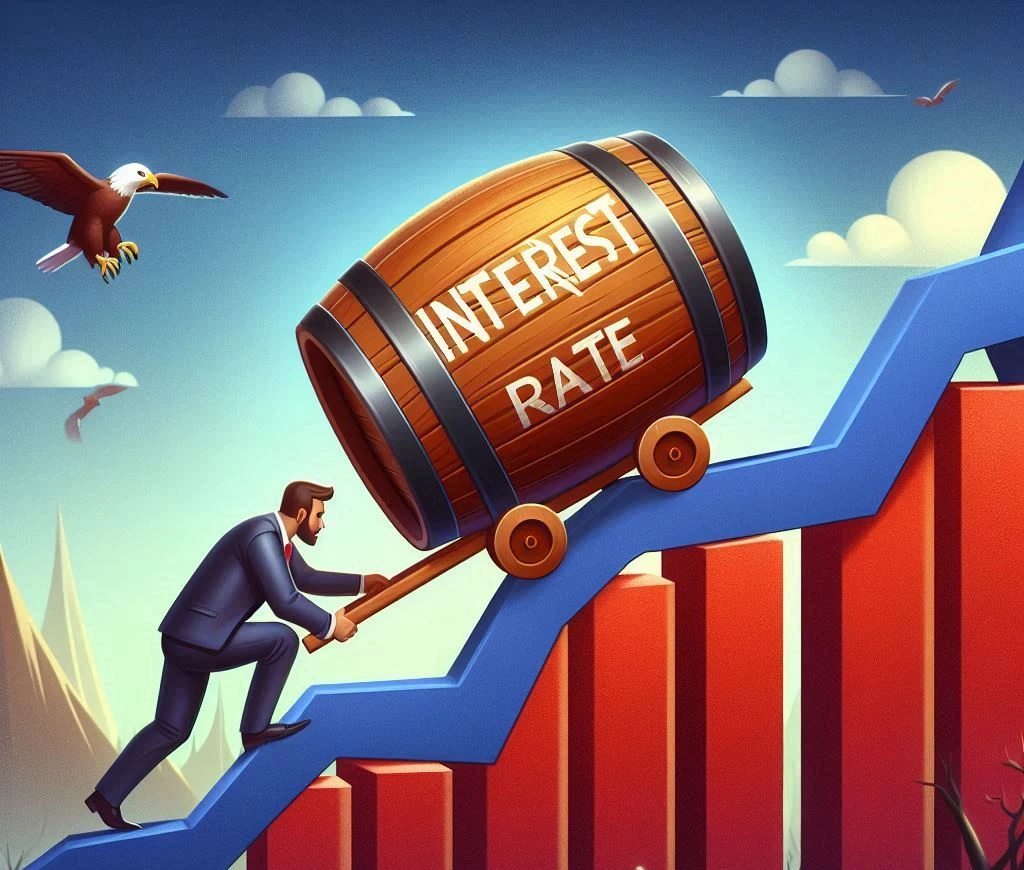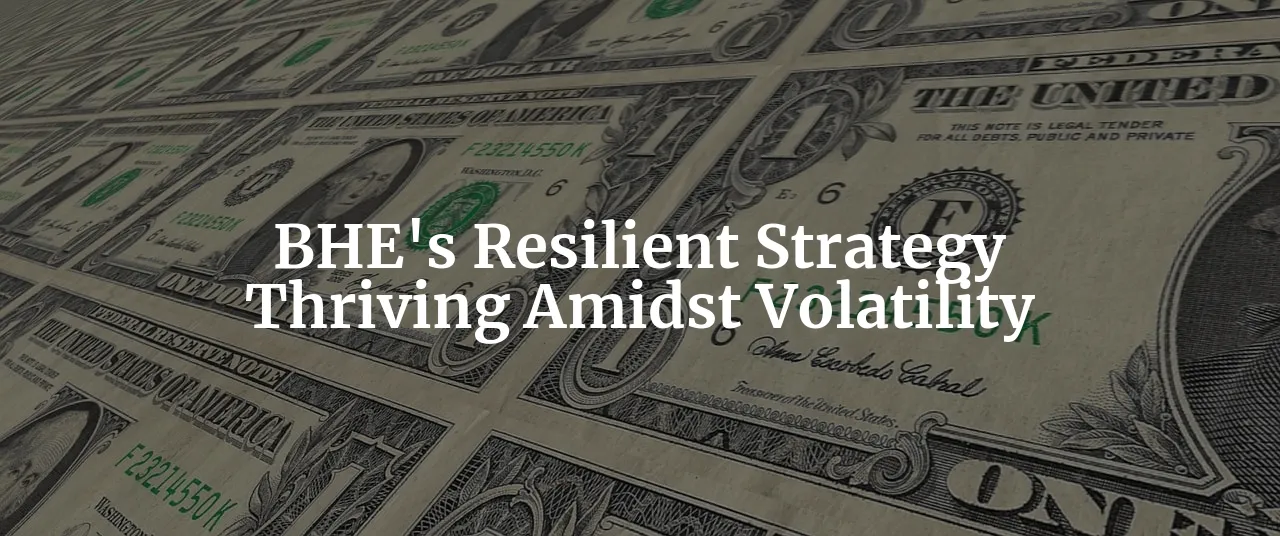Tags: BHE / Earnings
This fanpage is not officially affiliated with Berkshire Hathaway: Disclaimer
As elevated interest rates reshape the economic landscape, Berkshire Hathaway Energy Company (BHE) faces both challenges and opportunities. Discover what’s beneficial for Berkshire Hathaway's insurance subsidiaries ↗ but places a strain on its capital-intensive businesses. Discover the full story!

Introduction
92% owned Berkshire Hathaway Energy Company (BHE) has long been a cornerstone of Berkshire Hathaway's diversified portfolio, showcasing a robust growth trajectory and financial stability over the years. Historically, BHE has demonstrated resilience and adaptability, navigating various economic landscapes while maintaining a strong foothold in the energy sector. The company's expansive operations, which include regulated utilities and natural gas pipelines, span across multiple U.S. states such as Oregon, Utah, Wyoming, Iowa, Illinois, and Nevada 1.
However, the first half of 2024 has brought new challenges, primarily in the form of elevated interest rates. As the Federal Reserve continues to hike rates to combat inflation, the broader economic environment has shifted, creating ripple effects across industries. For the energy sector, these elevated rates have significant implications, influencing everything from operational costs to capital expenditure and debt servicing.
Adding to the complexity, recent political decisions, such as the Bipartisan Infrastructure Law and the Inflation Reduction Act, have introduced new regulatory and financial frameworks. These laws aim to modernize infrastructure and promote renewable energy, respectively, potentially altering the competitive landscape and operational dynamics for companies like BHE.
For Berkshire Hathaway's shareholders, understanding these financial dynamics is crucial. The interplay between elevated interest rates, regulatory changes, and BHE's operational performance directly impacts the company's profitability and, by extension, shareholder value. This article delves into the financial performance of BHE in the first half of 2024, highlighting the influence of elevated interest rates 67 and other key factors.
The primary argument here is that elevated interest rates are significantly affecting BHE's financial performance in H1 2024. By examining detailed financial metrics and contextualizing them within the current economic and political backdrop, we aim to provide shareholders with a comprehensive understanding of BHE's journey through these turbulent times.
Financial Performance Overview
The financial landscape for BHE in the first half of 2024 presents a mixed bag of outcomes, reflecting both challenges and areas of resilience. Notably, net earnings declined by $163 million in Q2 2024, a stark contrast to the $50 million increase in net earnings for the first six months of 2024 compared to the same period in 2023 1. This dichotomy underscores the volatile nature of the current economic environment and its impact on BHE's performance.
One of the bright spots in BHE's financials is the electric utility margin, which saw an increase of $79 million (4.4%) in Q2 2024 and $102 million (2.9%) in the first six months of 2024 compared to the previous year1. This growth can be attributed to higher retail customer volumes and operational efficiencies across BHE's U.S. utilities.
On the downside, pre-tax loss accruals for wildfires amounted to $251 million in Q2 and the first six months of 2024, although this is an improvement from the $408 million recorded in the first six months of 20231 ↗. The reduction in wildfire-related losses indicates better risk management and mitigation strategies, yet it remains a significant financial burden.
The natural gas pipelines segment has shown robust performance, with net earnings increasing by $47 million in Q2 and $177 million in the first six months of 2024 compared to 2023 1. This growth highlights the critical role of natural gas in BHE's diversified energy portfolio, providing a stable revenue stream amid fluctuating market conditions.
Conversely, the renewable energy business faced headwinds, with earnings decreasing due to lower returns from wind tax equity investments and the absence of debt extinguishment gains recognized in 20231. This decline underscores the challenges in the renewable sector, particularly in a high-interest-rate environment that affects financing costs and investment returns.
Retail customer volumes have been a positive indicator, increasing by 3.2% overall in the first six months of 2024. Specific gains were noted for NV Energy (up 5.4%), PacifiCorp (up 3.3%), and MEC (up 0.7%)1. These increases reflect strong demand and customer growth, which are vital for sustaining revenue and margin improvements.
Here's an overview based on Berkshire Hathaway's 10-Q 1, amounts in million dollars:
| Berkshire Hathaway Energy Financial Metric | Q2 2024 | Q2 2023 | H1 2024 | H1 2023 |
|---|---|---|---|---|
| Energy operating revenue | $5,115 | $4,933 | $10,360 | $10,404 |
| Real estate operating revenue | $1,289 | $1,296 | $2,155 | $2,171 |
| Other income | $88 | $133 | $254 | $238 |
| Total revenue | $6,492 | $6,362 | $12,769 | $12,813 |
| Energy cost of sales | $1,527 | $1,566 | $3,197 | $3,521 |
| Energy operating expenses | $2,774 😮 | $2,357 | $5,218 | $5,147 |
| Real estate operating costs and expenses | $1,240 | $1,250 | $2,326 | $2,170 |
| Interest expense | $625 😮 | $565 | $1,270 | $1,128 |
| Total costs and expenses | $6,166 | $5,738 | $12,011 | $11,966 |
| Pre-tax earnings | $326 | $624 | $758 | $847 |
| Income tax benefit | ($434) | ($379) | ($827) | ($742) |
| Net earnings after income taxes | $760 | $1,003 | $1,585 | $1,589 |
| Noncontrolling interests of BHE subsidiaries | $39 | $130 | $75 | $244 |
| Net earnings attributable to BHE | $721 | $873 | $1,510 | $1,345 |
| Noncontrolling interests and preferred stock dividends | $66 | $88 | $138 | $144 |
| Net earnings attributable to Berkshire Hathaway shareholders | $655 | $785 | $1,372 | $1,201 |
Apparently, also operating expenses were elevated. The quarterly report provides the following explanation: "The increases in other energy operating expenses were primarily due to higher vegetation management and other wildfire mitigation costs, legal and insurance expenses and general and plant maintenance costs" 1. We have partly covered these aspects in the past but it would clearly be an elaborate topic on its own ↗. In Berkshire Hathaway Energy's report, further details are outlined about wildfires for example in Oregan and California 2. PacifiCorp's current liability for estimated losses associated with wildfires are around $1.9 billion 2.
Yes, you read that correctly. Certainly, Warren Buffett and Greg Abel will have their say on these liabilities during next year's shareholder meeting. We count on it. For now, let us consider something much more easy to understand and estimate:
Impact of Elevated Interest Rates
The still elevated interest rates in the first half of 2024 have had a notable impact on Berkshire Hathaway Energy Company (BHE) ↗. The company's interest expense increased by $84 million in Q2 and $186 million in the first six months of 2024, largely due to $4.4 billion in subsidiary term debt issued in January 2024 at a 5.5% interest rate 1. This significant rise in borrowing costs underscores the broader economic implications of an environment characterized by increasing interest rates.
Historically, interest rates have fluctuated significantly, impacting corporate debt and financial performance across various sectors, including energy. During periods of low interest rates, companies often take advantage of cheaper borrowing costs to finance expansions and investments. Conversely, periods of high interest rates typically lead to increased borrowing costs, which can constrain financial performance and investment capacity. For instance, the energy sector saw similar challenges during the early 1980s when interest rates soared, leading to higher costs of capital and reduced profitability.
Elevated interest rates generally increase borrowing costs for companies, affecting their ability to finance operations and expansions. This can lead to reduced profitability and slower growth. Moreover, higher interest rates can dampen consumer spending and investment, potentially leading to broader economic slowdowns. For BHE, the increased interest expense directly impacts net earnings, as seen in the recent financial reports.
Government policies and Federal Reserve decisions play a crucial role in influencing interest rates. The Federal Reserve's monetary policy, particularly its decisions on the federal funds rate, directly impacts borrowing costs for businesses. Political factors, such as fiscal policies and regulatory changes, also influence the broader economic environment. For example, the recent interest rate hikes are part of the Federal Reserve's efforts to combat inflation, which has broader implications for corporate financials.
To mitigate the impact of elevated interest rates, BHE and other energy companies might consider several strategic responses:
- Debt Restructuring: Refinancing existing debt at more favorable terms.
- Cost Management: Implementing cost-cutting measures to improve operational efficiency.
- Revenue Diversification: Expanding into new markets or business segments to enhance revenue streams.
- Hedging Strategies: Using financial instruments to hedge against interest rate fluctuations.
- Capital Allocation: Prioritizing high-return investments to maximize profitability.
The impact of elevated interest rates on BHE's different business segments can be summarized as follows:
- Utilities: Increased borrowing costs may affect capital expenditures for infrastructure upgrades and expansions.
- Natural Gas Pipelines: Higher interest expenses could impact profitability, although the segment saw an increase in net earnings by $47 million in Q2 and $177 million in the first six months of 2024 1.
- Renewables: The renewable energy business experienced a decrease in earnings due to lower returns from wind tax equity investments and debt extinguishment gains recognized in 2023 1.
Broader Industry and Market Dynamics
The energy sector is undergoing significant transformations, driven by trends towards renewable energy and the increasing importance of energy security. The International Energy Agency (IEA)'s latest review highlights the US leadership in these areas, noting a nearly 60% surge in clean energy investment over the past four years, creating over 310,000 jobs in the sector 3.
The shift towards renewable energy is reshaping the energy landscape. The Bipartisan Infrastructure Law (BIL) and the Inflation Reduction Act (IRA) aim to reduce emissions by 50% to 52% from 2005 levels by 2030 and achieve a net zero energy system by 2050 3. These policies are driving investments in clean energy technologies, including solar, wind, and battery storage, which have seen significant growth.
Technological advancements are also playing a crucial role in the energy transition. A notable example is the joint venture between Occidental Petroleum and BHE to extract lithium from geothermal electricity production. This innovative approach leverages TerraLithium's technology at BHE Renewables' Imperial Valley geothermal facility, potentially positioning the region as a global leader in lithium production 4. Such innovations are essential for meeting the growing demand for electric vehicles and renewable energy storage solutions.
Global market dynamics, including geopolitical events like Russia's invasion of Ukraine, have significant implications for energy markets. The US, as the world's largest oil and gas producer, plays a pivotal role in stabilizing global markets. The increased focus on energy security and diversification of energy sources is a direct response to such geopolitical challenges.
Drawing parallels with historical periods of energy transition and market volatility provides a deeper understanding of current trends. For instance, the oil crises of the 1970s led to significant investments in energy efficiency and alternative energy sources. Similarly, the current transition towards renewable energy is driven by the need for sustainability and resilience in the face of climate change and geopolitical uncertainties.
| Energy Source | Production (Quads) | Consumption (Quads) |
|---|---|---|
| Natural Gas | 39.25 | 33.61 |
| Petroleum | 35.24 | 35.00 |
| Renewable Energy | 8.43 | 8.24 |
| Coal | 11.81 | 11.00 |
| Nuclear Electric Power | 8.10 | 8.10 |
This table summarizes key market data from the U.S. Energy Information Administration (EIA), highlighting the production and consumption of various energy sources in 2023 5. It underscores the significant role of natural gas and petroleum, while also reflecting the growing contribution of renewable energy. Here, Quads is short for quadrillion British thermal units. Interestingly, U.S. total annual production has significantly exceeded consumption since 2019 5. The energy sector is at a critical juncture, with rising interest rates and broader market dynamics shaping its future. BHE's strategic responses and innovations position it well to navigate these challenges and capitalize on emerging opportunities.

Conclusion
The first half of 2024 has presented Berkshire Hathaway Energy Company (BHE) with a complex landscape shaped by elevated interest rates, evolving market dynamics and complex liabilities. While the company has shown resilience in certain segments—such as the electric utility and natural gas pipelines—challenges remain, particularly in the renewable energy sector and due to increased interest expenses. The decline in net earnings, juxtaposed with growth in electric utility margins and retail customer volumes, illustrates the volatile nature of the current economic environment and its direct implications for BHE's financial performance.
Looking forward, BHE is well-positioned to navigate the challenges posed by elevated interest rates and other market dynamics. Strategic responses, including debt restructuring, cost management, and revenue diversification, will be crucial in mitigating the adverse effects of increased borrowing costs. Furthermore, as the energy sector continues its transition towards sustainability, BHE's investments in innovative technologies and renewable energy will likely open new avenues for growth and profitability.
For shareholders, staying informed about macroeconomic trends and company-specific developments is essential. The interplay between rising interest rates, regulatory changes, and BHE's operational performance will continue to shape the company’s trajectory. Investors should view this period as an opportunity to support BHE's strategic initiatives while remaining vigilant about the broader economic landscape.
Historically, the energy sector has faced numerous challenges, from the oil crises of the 1970s to the current geopolitical tensions affecting global markets. As Warren Buffett wisely noted, "The stock market is designed to transfer money from the Active to the Patient." This sentiment underscores the importance of a long-term perspective amidst financial fluctuations.
As we move forward, shareholders are encouraged to engage with BHE's ongoing developments and participate in shareholder meetings to stay updated on strategic decisions ↗. The resilience and adaptability of Berkshire Hathaway and its subsidiaries have proven effective in navigating complex financial landscapes, and this track record instills confidence in BHE's ability to thrive in the face of adversity.
While the road ahead may be fraught with challenges, BHE's commitment to innovation, operational efficiency, and strategic growth positions it favorably for the future. Together, we can navigate these turbulent waters and emerge stronger, reinforcing our belief in the enduring potential of the energy sector.
References
-
2024 Second Quarter Report - www.berkshirehathaway.com ↩↩↩↩↩↩↩↩↩↩↩↩
-
BHE June 2024 10-Q - www.brkenergy.com ↩↩
-
IEA policy review highlights leadership of United States on energy security and clean energy transitions - News - IEA - www.iea.org ↩↩
-
Warren Buffett Gathers His Energy Gang To Extract Lithium - www.investors.com ↩
-
U.S. Energy Information Administration - EIA - Independent Statistics and Analysis - www.eia.gov ↩↩
-
Federal Funds Effective Rate - fred.stlouisfed.org; Note: Historically, interest rates have seen wild swings. The current 5%-ish interest rates are not exceptional territory. ↩
-
Federal Funds Rate History: 1980 Through The Present | Bankrate - www.bankrate.com ↩












